Exploring Communication Models and Methods in Business Contexts
VerifiedAdded on 2023/01/11
|14
|4051
|44
Report
AI Summary
This report provides a comprehensive overview of communication skills in a business context. It begins by examining various communication models, including Aristotle's model and the Osgood-Schramm circular model, highlighting their application in business settings. The report then explores different communication methods, such as written, verbal, non-verbal, and electronic, within formal and informal communication systems, detailing their benefits and drawbacks. It further explains the principles of effective communication, emphasizing clarity, simplicity, timeliness, and adequacy. The role of technology in both formal and informal communication is also discussed, along with potential barriers to effective communication. The report also touches upon oral and written business communication styles and methods. This document is available on Desklib, a platform offering a range of study tools and solved assignments for students.
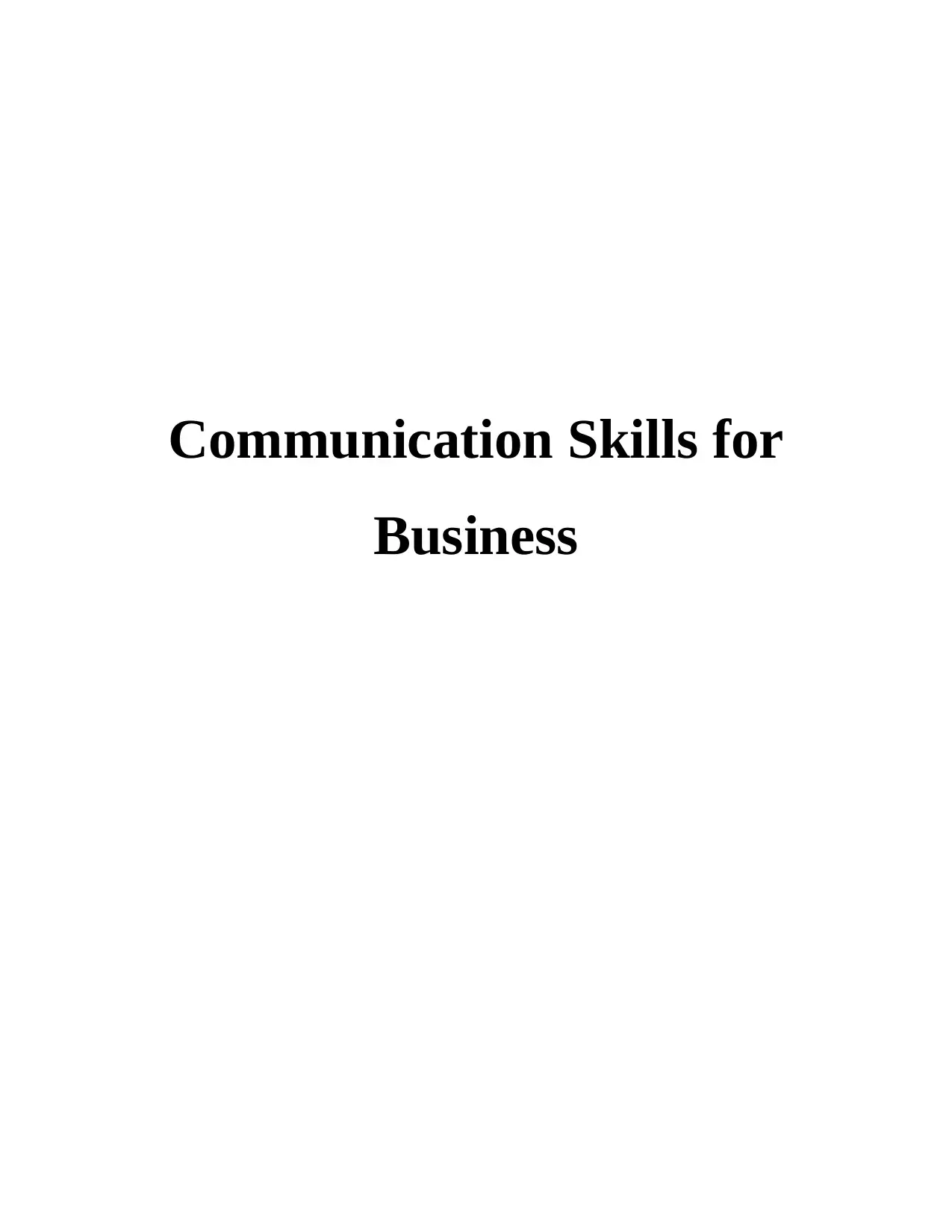
Communication Skills for
Business
Business
Paraphrase This Document
Need a fresh take? Get an instant paraphrase of this document with our AI Paraphraser
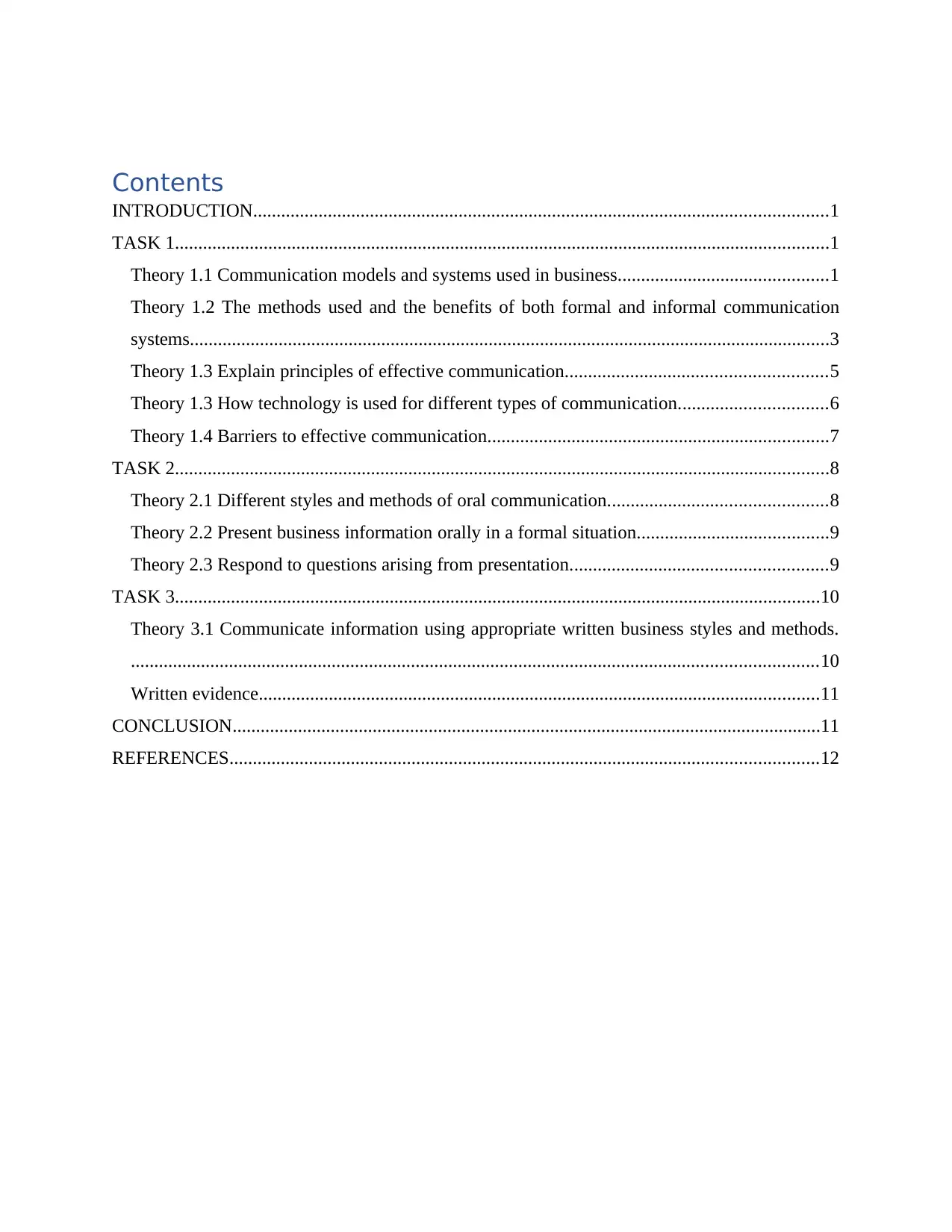
Contents
INTRODUCTION...........................................................................................................................1
TASK 1............................................................................................................................................1
Theory 1.1 Communication models and systems used in business.............................................1
Theory 1.2 The methods used and the benefits of both formal and informal communication
systems.........................................................................................................................................3
Theory 1.3 Explain principles of effective communication........................................................5
Theory 1.3 How technology is used for different types of communication................................6
Theory 1.4 Barriers to effective communication.........................................................................7
TASK 2............................................................................................................................................8
Theory 2.1 Different styles and methods of oral communication...............................................8
Theory 2.2 Present business information orally in a formal situation.........................................9
Theory 2.3 Respond to questions arising from presentation.......................................................9
TASK 3..........................................................................................................................................10
Theory 3.1 Communicate information using appropriate written business styles and methods.
...................................................................................................................................................10
Written evidence........................................................................................................................11
CONCLUSION..............................................................................................................................11
REFERENCES..............................................................................................................................12
INTRODUCTION...........................................................................................................................1
TASK 1............................................................................................................................................1
Theory 1.1 Communication models and systems used in business.............................................1
Theory 1.2 The methods used and the benefits of both formal and informal communication
systems.........................................................................................................................................3
Theory 1.3 Explain principles of effective communication........................................................5
Theory 1.3 How technology is used for different types of communication................................6
Theory 1.4 Barriers to effective communication.........................................................................7
TASK 2............................................................................................................................................8
Theory 2.1 Different styles and methods of oral communication...............................................8
Theory 2.2 Present business information orally in a formal situation.........................................9
Theory 2.3 Respond to questions arising from presentation.......................................................9
TASK 3..........................................................................................................................................10
Theory 3.1 Communicate information using appropriate written business styles and methods.
...................................................................................................................................................10
Written evidence........................................................................................................................11
CONCLUSION..............................................................................................................................11
REFERENCES..............................................................................................................................12
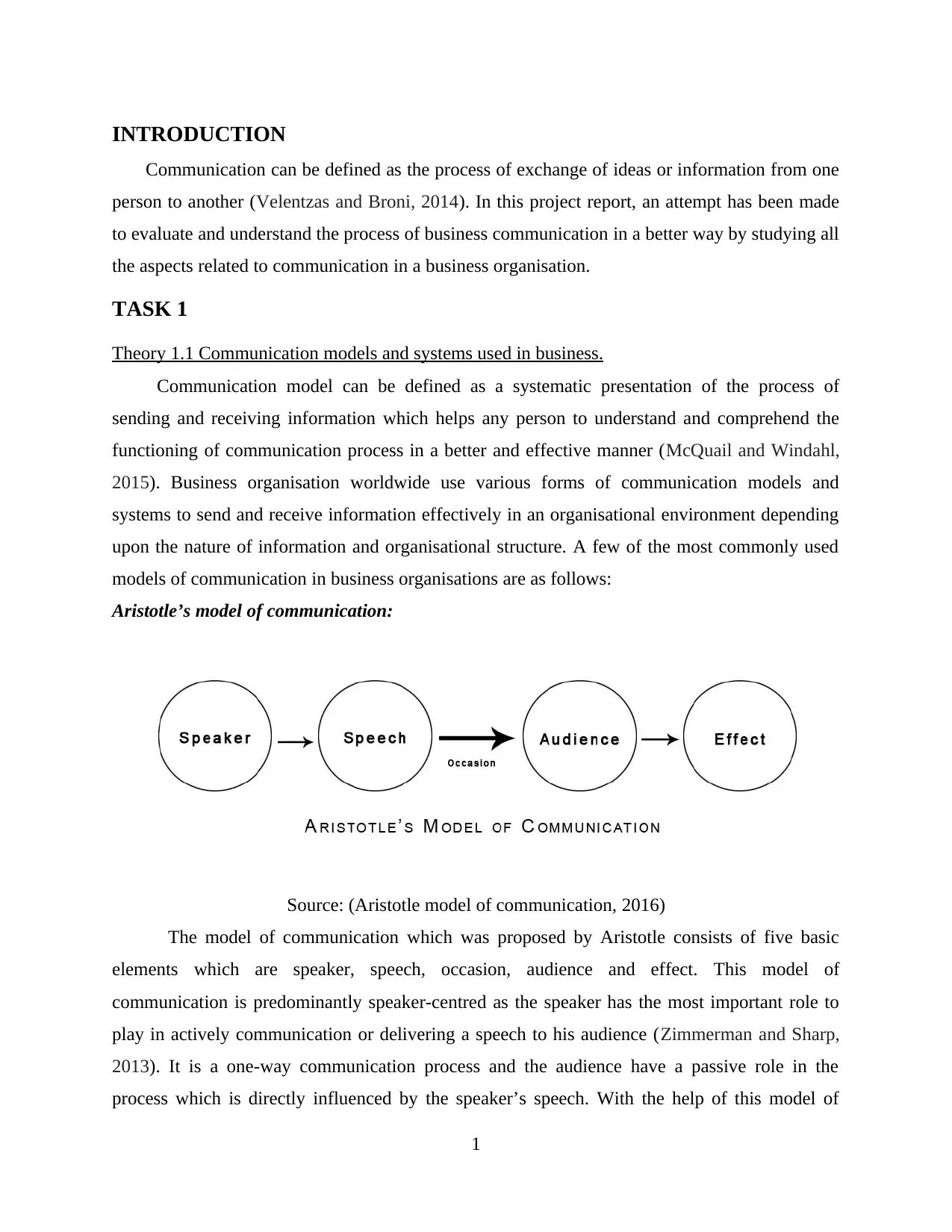
INTRODUCTION
Communication can be defined as the process of exchange of ideas or information from one
person to another (Velentzas and Broni, 2014). In this project report, an attempt has been made
to evaluate and understand the process of business communication in a better way by studying all
the aspects related to communication in a business organisation.
TASK 1
Theory 1.1 Communication models and systems used in business.
Communication model can be defined as a systematic presentation of the process of
sending and receiving information which helps any person to understand and comprehend the
functioning of communication process in a better and effective manner (McQuail and Windahl,
2015). Business organisation worldwide use various forms of communication models and
systems to send and receive information effectively in an organisational environment depending
upon the nature of information and organisational structure. A few of the most commonly used
models of communication in business organisations are as follows:
Aristotle’s model of communication:
Source: (Aristotle model of communication, 2016)
The model of communication which was proposed by Aristotle consists of five basic
elements which are speaker, speech, occasion, audience and effect. This model of
communication is predominantly speaker-centred as the speaker has the most important role to
play in actively communication or delivering a speech to his audience (Zimmerman and Sharp,
2013). It is a one-way communication process and the audience have a passive role in the
process which is directly influenced by the speaker’s speech. With the help of this model of
1
Communication can be defined as the process of exchange of ideas or information from one
person to another (Velentzas and Broni, 2014). In this project report, an attempt has been made
to evaluate and understand the process of business communication in a better way by studying all
the aspects related to communication in a business organisation.
TASK 1
Theory 1.1 Communication models and systems used in business.
Communication model can be defined as a systematic presentation of the process of
sending and receiving information which helps any person to understand and comprehend the
functioning of communication process in a better and effective manner (McQuail and Windahl,
2015). Business organisation worldwide use various forms of communication models and
systems to send and receive information effectively in an organisational environment depending
upon the nature of information and organisational structure. A few of the most commonly used
models of communication in business organisations are as follows:
Aristotle’s model of communication:
Source: (Aristotle model of communication, 2016)
The model of communication which was proposed by Aristotle consists of five basic
elements which are speaker, speech, occasion, audience and effect. This model of
communication is predominantly speaker-centred as the speaker has the most important role to
play in actively communication or delivering a speech to his audience (Zimmerman and Sharp,
2013). It is a one-way communication process and the audience have a passive role in the
process which is directly influenced by the speaker’s speech. With the help of this model of
1
⊘ This is a preview!⊘
Do you want full access?
Subscribe today to unlock all pages.

Trusted by 1+ million students worldwide
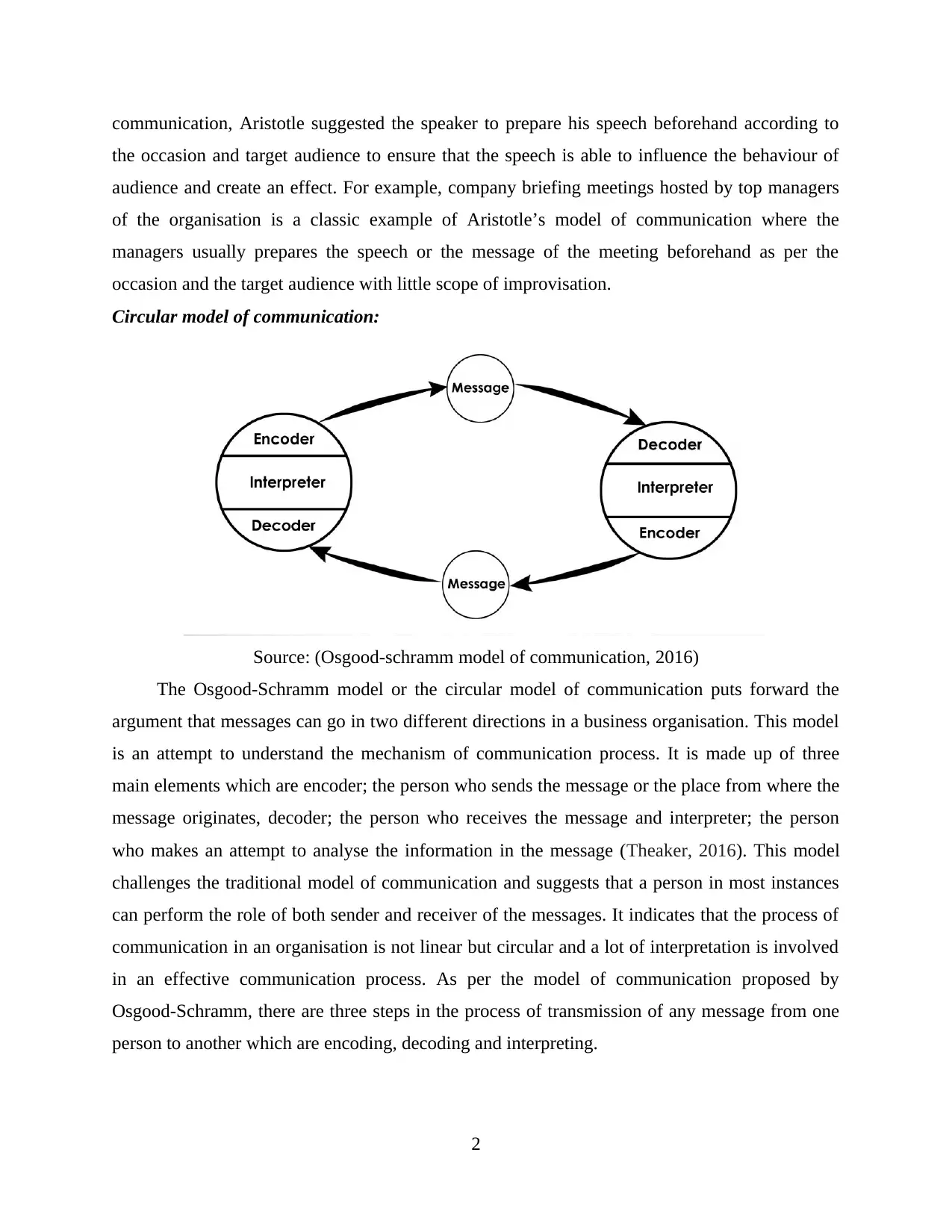
communication, Aristotle suggested the speaker to prepare his speech beforehand according to
the occasion and target audience to ensure that the speech is able to influence the behaviour of
audience and create an effect. For example, company briefing meetings hosted by top managers
of the organisation is a classic example of Aristotle’s model of communication where the
managers usually prepares the speech or the message of the meeting beforehand as per the
occasion and the target audience with little scope of improvisation.
Circular model of communication:
Source: (Osgood-schramm model of communication, 2016)
The Osgood-Schramm model or the circular model of communication puts forward the
argument that messages can go in two different directions in a business organisation. This model
is an attempt to understand the mechanism of communication process. It is made up of three
main elements which are encoder; the person who sends the message or the place from where the
message originates, decoder; the person who receives the message and interpreter; the person
who makes an attempt to analyse the information in the message (Theaker, 2016). This model
challenges the traditional model of communication and suggests that a person in most instances
can perform the role of both sender and receiver of the messages. It indicates that the process of
communication in an organisation is not linear but circular and a lot of interpretation is involved
in an effective communication process. As per the model of communication proposed by
Osgood-Schramm, there are three steps in the process of transmission of any message from one
person to another which are encoding, decoding and interpreting.
2
the occasion and target audience to ensure that the speech is able to influence the behaviour of
audience and create an effect. For example, company briefing meetings hosted by top managers
of the organisation is a classic example of Aristotle’s model of communication where the
managers usually prepares the speech or the message of the meeting beforehand as per the
occasion and the target audience with little scope of improvisation.
Circular model of communication:
Source: (Osgood-schramm model of communication, 2016)
The Osgood-Schramm model or the circular model of communication puts forward the
argument that messages can go in two different directions in a business organisation. This model
is an attempt to understand the mechanism of communication process. It is made up of three
main elements which are encoder; the person who sends the message or the place from where the
message originates, decoder; the person who receives the message and interpreter; the person
who makes an attempt to analyse the information in the message (Theaker, 2016). This model
challenges the traditional model of communication and suggests that a person in most instances
can perform the role of both sender and receiver of the messages. It indicates that the process of
communication in an organisation is not linear but circular and a lot of interpretation is involved
in an effective communication process. As per the model of communication proposed by
Osgood-Schramm, there are three steps in the process of transmission of any message from one
person to another which are encoding, decoding and interpreting.
2
Paraphrase This Document
Need a fresh take? Get an instant paraphrase of this document with our AI Paraphraser
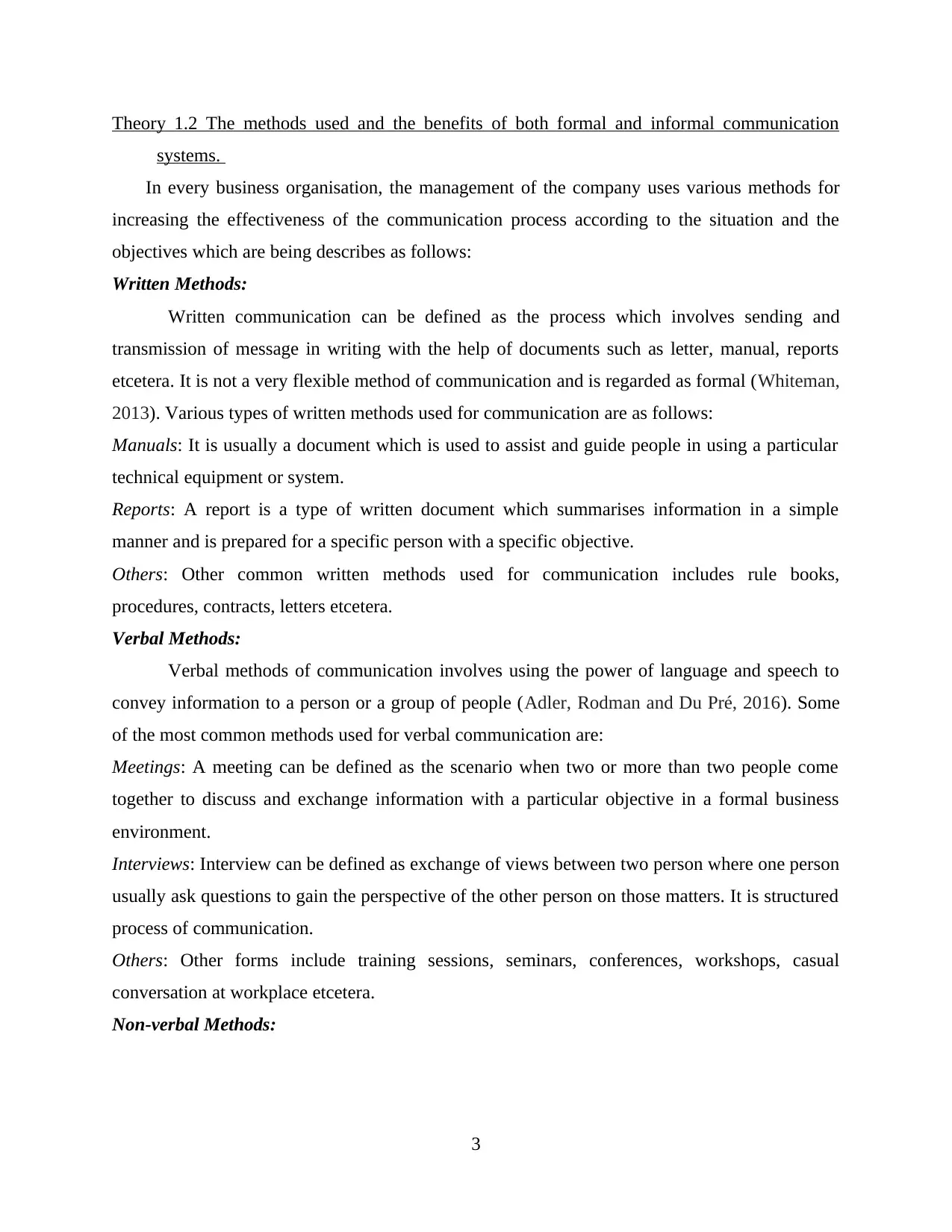
Theory 1.2 The methods used and the benefits of both formal and informal communication
systems.
In every business organisation, the management of the company uses various methods for
increasing the effectiveness of the communication process according to the situation and the
objectives which are being describes as follows:
Written Methods:
Written communication can be defined as the process which involves sending and
transmission of message in writing with the help of documents such as letter, manual, reports
etcetera. It is not a very flexible method of communication and is regarded as formal (Whiteman,
2013). Various types of written methods used for communication are as follows:
Manuals: It is usually a document which is used to assist and guide people in using a particular
technical equipment or system.
Reports: A report is a type of written document which summarises information in a simple
manner and is prepared for a specific person with a specific objective.
Others: Other common written methods used for communication includes rule books,
procedures, contracts, letters etcetera.
Verbal Methods:
Verbal methods of communication involves using the power of language and speech to
convey information to a person or a group of people (Adler, Rodman and Du Pré, 2016). Some
of the most common methods used for verbal communication are:
Meetings: A meeting can be defined as the scenario when two or more than two people come
together to discuss and exchange information with a particular objective in a formal business
environment.
Interviews: Interview can be defined as exchange of views between two person where one person
usually ask questions to gain the perspective of the other person on those matters. It is structured
process of communication.
Others: Other forms include training sessions, seminars, conferences, workshops, casual
conversation at workplace etcetera.
Non-verbal Methods:
3
systems.
In every business organisation, the management of the company uses various methods for
increasing the effectiveness of the communication process according to the situation and the
objectives which are being describes as follows:
Written Methods:
Written communication can be defined as the process which involves sending and
transmission of message in writing with the help of documents such as letter, manual, reports
etcetera. It is not a very flexible method of communication and is regarded as formal (Whiteman,
2013). Various types of written methods used for communication are as follows:
Manuals: It is usually a document which is used to assist and guide people in using a particular
technical equipment or system.
Reports: A report is a type of written document which summarises information in a simple
manner and is prepared for a specific person with a specific objective.
Others: Other common written methods used for communication includes rule books,
procedures, contracts, letters etcetera.
Verbal Methods:
Verbal methods of communication involves using the power of language and speech to
convey information to a person or a group of people (Adler, Rodman and Du Pré, 2016). Some
of the most common methods used for verbal communication are:
Meetings: A meeting can be defined as the scenario when two or more than two people come
together to discuss and exchange information with a particular objective in a formal business
environment.
Interviews: Interview can be defined as exchange of views between two person where one person
usually ask questions to gain the perspective of the other person on those matters. It is structured
process of communication.
Others: Other forms include training sessions, seminars, conferences, workshops, casual
conversation at workplace etcetera.
Non-verbal Methods:
3
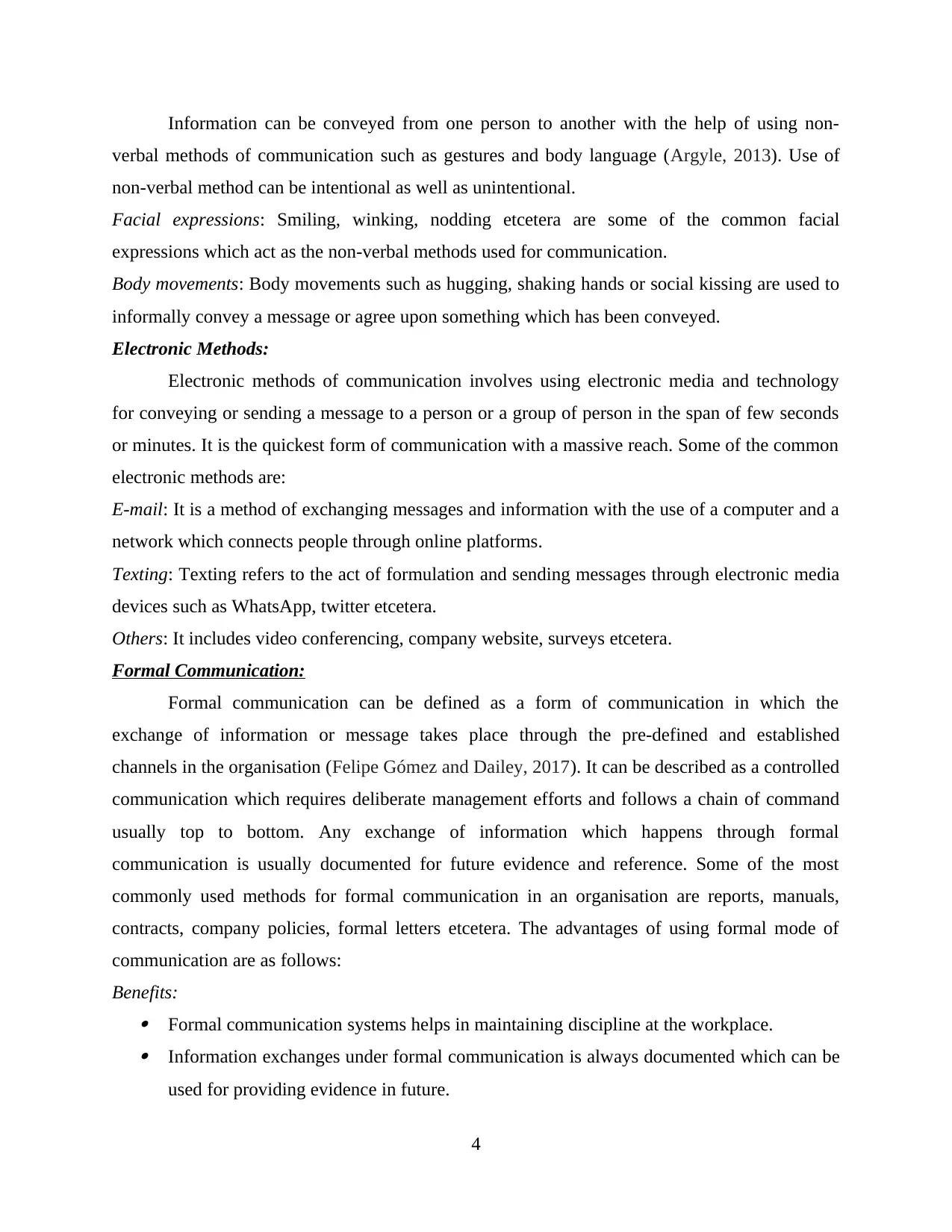
Information can be conveyed from one person to another with the help of using non-
verbal methods of communication such as gestures and body language (Argyle, 2013). Use of
non-verbal method can be intentional as well as unintentional.
Facial expressions: Smiling, winking, nodding etcetera are some of the common facial
expressions which act as the non-verbal methods used for communication.
Body movements: Body movements such as hugging, shaking hands or social kissing are used to
informally convey a message or agree upon something which has been conveyed.
Electronic Methods:
Electronic methods of communication involves using electronic media and technology
for conveying or sending a message to a person or a group of person in the span of few seconds
or minutes. It is the quickest form of communication with a massive reach. Some of the common
electronic methods are:
E-mail: It is a method of exchanging messages and information with the use of a computer and a
network which connects people through online platforms.
Texting: Texting refers to the act of formulation and sending messages through electronic media
devices such as WhatsApp, twitter etcetera.
Others: It includes video conferencing, company website, surveys etcetera.
Formal Communication:
Formal communication can be defined as a form of communication in which the
exchange of information or message takes place through the pre-defined and established
channels in the organisation (Felipe Gómez and Dailey, 2017). It can be described as a controlled
communication which requires deliberate management efforts and follows a chain of command
usually top to bottom. Any exchange of information which happens through formal
communication is usually documented for future evidence and reference. Some of the most
commonly used methods for formal communication in an organisation are reports, manuals,
contracts, company policies, formal letters etcetera. The advantages of using formal mode of
communication are as follows:
Benefits: Formal communication systems helps in maintaining discipline at the workplace. Information exchanges under formal communication is always documented which can be
used for providing evidence in future.
4
verbal methods of communication such as gestures and body language (Argyle, 2013). Use of
non-verbal method can be intentional as well as unintentional.
Facial expressions: Smiling, winking, nodding etcetera are some of the common facial
expressions which act as the non-verbal methods used for communication.
Body movements: Body movements such as hugging, shaking hands or social kissing are used to
informally convey a message or agree upon something which has been conveyed.
Electronic Methods:
Electronic methods of communication involves using electronic media and technology
for conveying or sending a message to a person or a group of person in the span of few seconds
or minutes. It is the quickest form of communication with a massive reach. Some of the common
electronic methods are:
E-mail: It is a method of exchanging messages and information with the use of a computer and a
network which connects people through online platforms.
Texting: Texting refers to the act of formulation and sending messages through electronic media
devices such as WhatsApp, twitter etcetera.
Others: It includes video conferencing, company website, surveys etcetera.
Formal Communication:
Formal communication can be defined as a form of communication in which the
exchange of information or message takes place through the pre-defined and established
channels in the organisation (Felipe Gómez and Dailey, 2017). It can be described as a controlled
communication which requires deliberate management efforts and follows a chain of command
usually top to bottom. Any exchange of information which happens through formal
communication is usually documented for future evidence and reference. Some of the most
commonly used methods for formal communication in an organisation are reports, manuals,
contracts, company policies, formal letters etcetera. The advantages of using formal mode of
communication are as follows:
Benefits: Formal communication systems helps in maintaining discipline at the workplace. Information exchanges under formal communication is always documented which can be
used for providing evidence in future.
4
⊘ This is a preview!⊘
Do you want full access?
Subscribe today to unlock all pages.

Trusted by 1+ million students worldwide
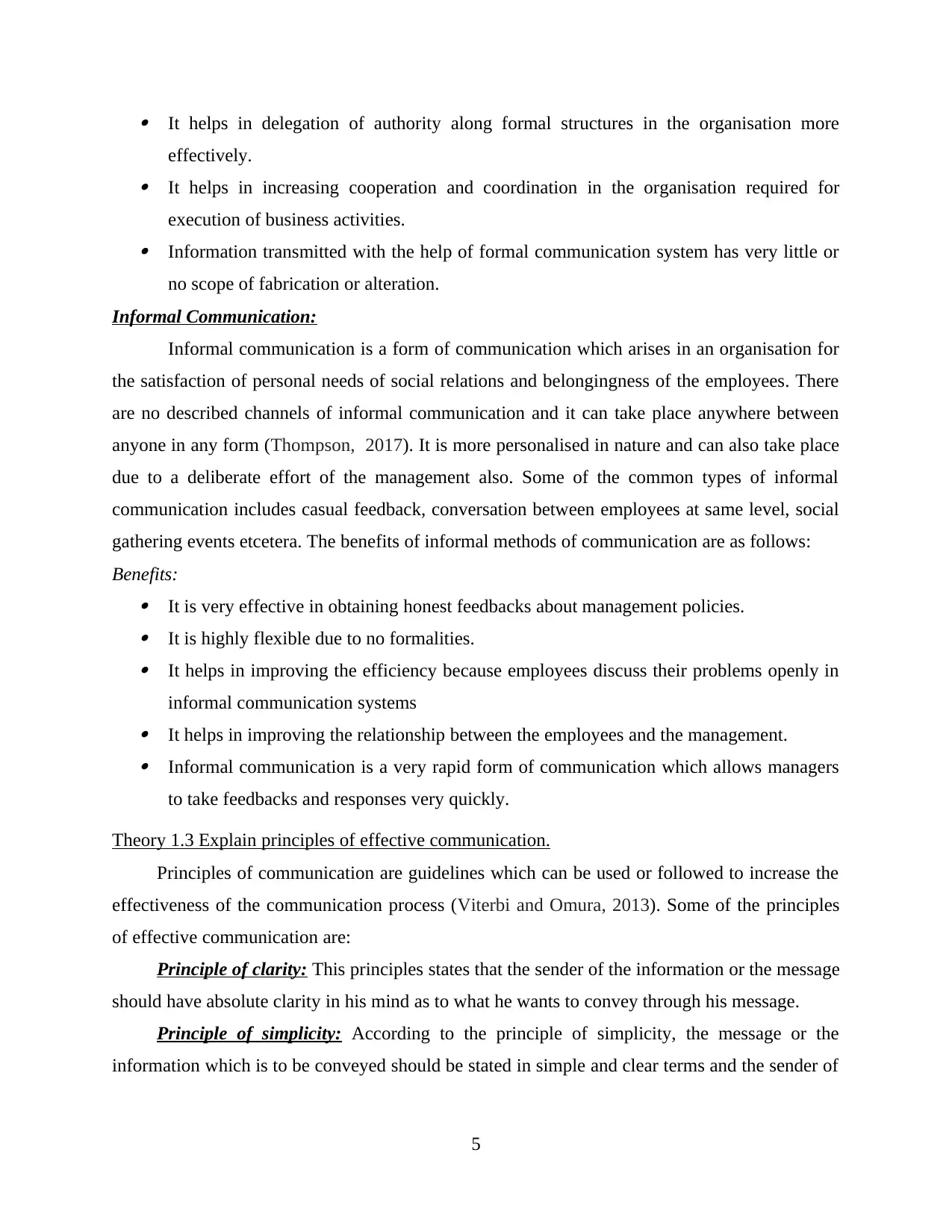
It helps in delegation of authority along formal structures in the organisation more
effectively. It helps in increasing cooperation and coordination in the organisation required for
execution of business activities. Information transmitted with the help of formal communication system has very little or
no scope of fabrication or alteration.
Informal Communication:
Informal communication is a form of communication which arises in an organisation for
the satisfaction of personal needs of social relations and belongingness of the employees. There
are no described channels of informal communication and it can take place anywhere between
anyone in any form (Thompson, 2017). It is more personalised in nature and can also take place
due to a deliberate effort of the management also. Some of the common types of informal
communication includes casual feedback, conversation between employees at same level, social
gathering events etcetera. The benefits of informal methods of communication are as follows:
Benefits: It is very effective in obtaining honest feedbacks about management policies. It is highly flexible due to no formalities. It helps in improving the efficiency because employees discuss their problems openly in
informal communication systems It helps in improving the relationship between the employees and the management. Informal communication is a very rapid form of communication which allows managers
to take feedbacks and responses very quickly.
Theory 1.3 Explain principles of effective communication.
Principles of communication are guidelines which can be used or followed to increase the
effectiveness of the communication process (Viterbi and Omura, 2013). Some of the principles
of effective communication are:
Principle of clarity: This principles states that the sender of the information or the message
should have absolute clarity in his mind as to what he wants to convey through his message.
Principle of simplicity: According to the principle of simplicity, the message or the
information which is to be conveyed should be stated in simple and clear terms and the sender of
5
effectively. It helps in increasing cooperation and coordination in the organisation required for
execution of business activities. Information transmitted with the help of formal communication system has very little or
no scope of fabrication or alteration.
Informal Communication:
Informal communication is a form of communication which arises in an organisation for
the satisfaction of personal needs of social relations and belongingness of the employees. There
are no described channels of informal communication and it can take place anywhere between
anyone in any form (Thompson, 2017). It is more personalised in nature and can also take place
due to a deliberate effort of the management also. Some of the common types of informal
communication includes casual feedback, conversation between employees at same level, social
gathering events etcetera. The benefits of informal methods of communication are as follows:
Benefits: It is very effective in obtaining honest feedbacks about management policies. It is highly flexible due to no formalities. It helps in improving the efficiency because employees discuss their problems openly in
informal communication systems It helps in improving the relationship between the employees and the management. Informal communication is a very rapid form of communication which allows managers
to take feedbacks and responses very quickly.
Theory 1.3 Explain principles of effective communication.
Principles of communication are guidelines which can be used or followed to increase the
effectiveness of the communication process (Viterbi and Omura, 2013). Some of the principles
of effective communication are:
Principle of clarity: This principles states that the sender of the information or the message
should have absolute clarity in his mind as to what he wants to convey through his message.
Principle of simplicity: According to the principle of simplicity, the message or the
information which is to be conveyed should be stated in simple and clear terms and the sender of
5
Paraphrase This Document
Need a fresh take? Get an instant paraphrase of this document with our AI Paraphraser
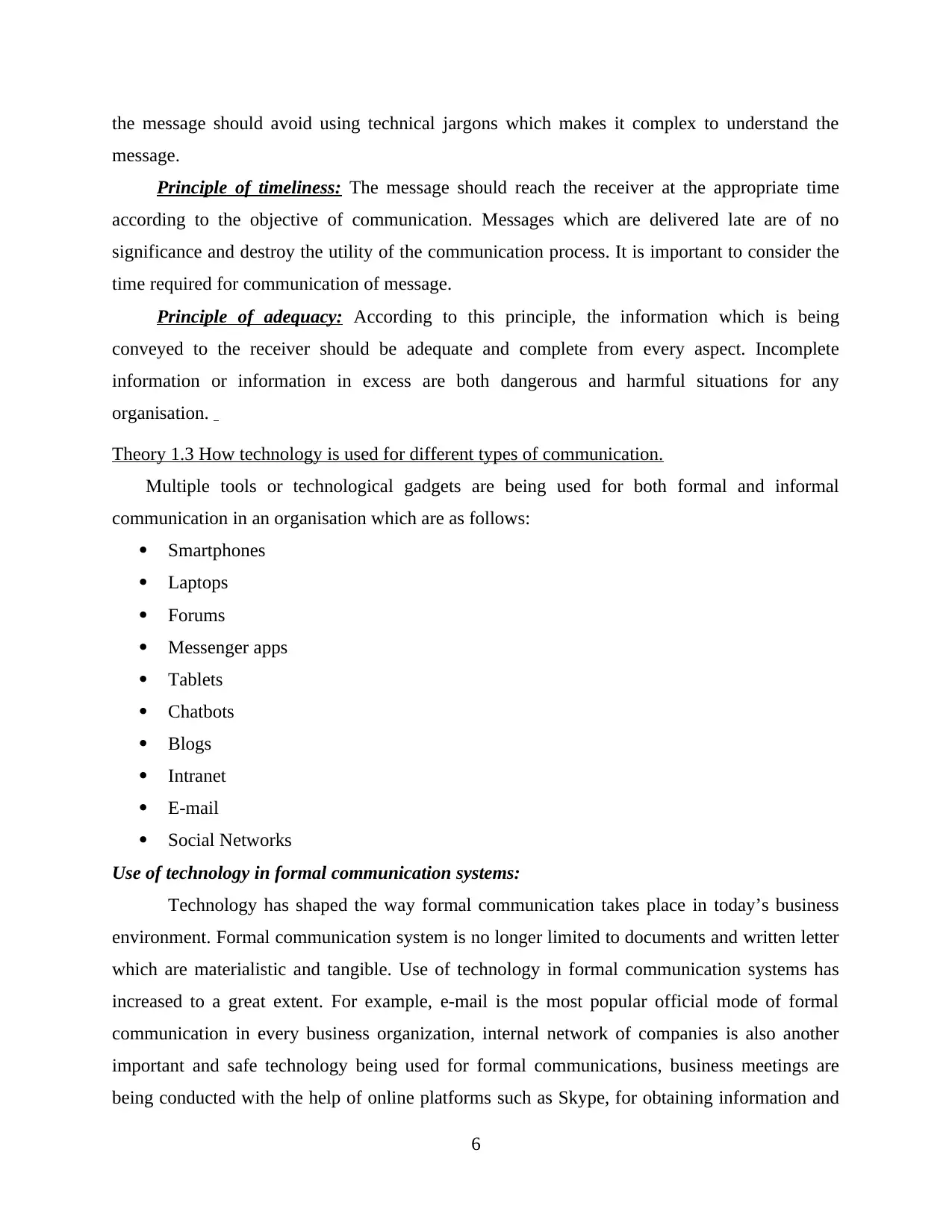
the message should avoid using technical jargons which makes it complex to understand the
message.
Principle of timeliness: The message should reach the receiver at the appropriate time
according to the objective of communication. Messages which are delivered late are of no
significance and destroy the utility of the communication process. It is important to consider the
time required for communication of message.
Principle of adequacy: According to this principle, the information which is being
conveyed to the receiver should be adequate and complete from every aspect. Incomplete
information or information in excess are both dangerous and harmful situations for any
organisation.
Theory 1.3 How technology is used for different types of communication.
Multiple tools or technological gadgets are being used for both formal and informal
communication in an organisation which are as follows:
Smartphones
Laptops
Forums
Messenger apps
Tablets
Chatbots
Blogs
Intranet
E-mail
Social Networks
Use of technology in formal communication systems:
Technology has shaped the way formal communication takes place in today’s business
environment. Formal communication system is no longer limited to documents and written letter
which are materialistic and tangible. Use of technology in formal communication systems has
increased to a great extent. For example, e-mail is the most popular official mode of formal
communication in every business organization, internal network of companies is also another
important and safe technology being used for formal communications, business meetings are
being conducted with the help of online platforms such as Skype, for obtaining information and
6
message.
Principle of timeliness: The message should reach the receiver at the appropriate time
according to the objective of communication. Messages which are delivered late are of no
significance and destroy the utility of the communication process. It is important to consider the
time required for communication of message.
Principle of adequacy: According to this principle, the information which is being
conveyed to the receiver should be adequate and complete from every aspect. Incomplete
information or information in excess are both dangerous and harmful situations for any
organisation.
Theory 1.3 How technology is used for different types of communication.
Multiple tools or technological gadgets are being used for both formal and informal
communication in an organisation which are as follows:
Smartphones
Laptops
Forums
Messenger apps
Tablets
Chatbots
Blogs
Intranet
Social Networks
Use of technology in formal communication systems:
Technology has shaped the way formal communication takes place in today’s business
environment. Formal communication system is no longer limited to documents and written letter
which are materialistic and tangible. Use of technology in formal communication systems has
increased to a great extent. For example, e-mail is the most popular official mode of formal
communication in every business organization, internal network of companies is also another
important and safe technology being used for formal communications, business meetings are
being conducted with the help of online platforms such as Skype, for obtaining information and
6
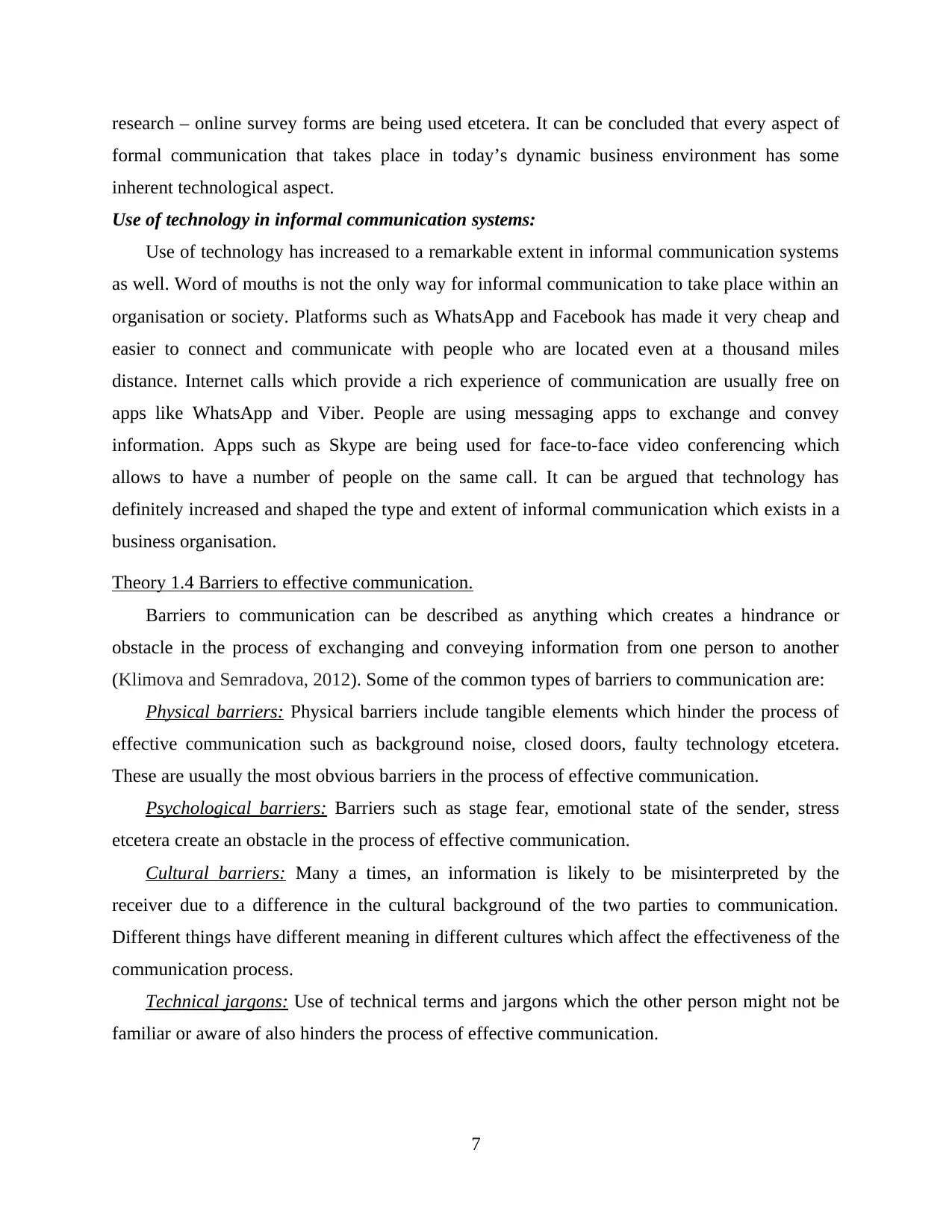
research – online survey forms are being used etcetera. It can be concluded that every aspect of
formal communication that takes place in today’s dynamic business environment has some
inherent technological aspect.
Use of technology in informal communication systems:
Use of technology has increased to a remarkable extent in informal communication systems
as well. Word of mouths is not the only way for informal communication to take place within an
organisation or society. Platforms such as WhatsApp and Facebook has made it very cheap and
easier to connect and communicate with people who are located even at a thousand miles
distance. Internet calls which provide a rich experience of communication are usually free on
apps like WhatsApp and Viber. People are using messaging apps to exchange and convey
information. Apps such as Skype are being used for face-to-face video conferencing which
allows to have a number of people on the same call. It can be argued that technology has
definitely increased and shaped the type and extent of informal communication which exists in a
business organisation.
Theory 1.4 Barriers to effective communication.
Barriers to communication can be described as anything which creates a hindrance or
obstacle in the process of exchanging and conveying information from one person to another
(Klimova and Semradova, 2012). Some of the common types of barriers to communication are:
Physical barriers: Physical barriers include tangible elements which hinder the process of
effective communication such as background noise, closed doors, faulty technology etcetera.
These are usually the most obvious barriers in the process of effective communication.
Psychological barriers: Barriers such as stage fear, emotional state of the sender, stress
etcetera create an obstacle in the process of effective communication.
Cultural barriers: Many a times, an information is likely to be misinterpreted by the
receiver due to a difference in the cultural background of the two parties to communication.
Different things have different meaning in different cultures which affect the effectiveness of the
communication process.
Technical jargons: Use of technical terms and jargons which the other person might not be
familiar or aware of also hinders the process of effective communication.
7
formal communication that takes place in today’s dynamic business environment has some
inherent technological aspect.
Use of technology in informal communication systems:
Use of technology has increased to a remarkable extent in informal communication systems
as well. Word of mouths is not the only way for informal communication to take place within an
organisation or society. Platforms such as WhatsApp and Facebook has made it very cheap and
easier to connect and communicate with people who are located even at a thousand miles
distance. Internet calls which provide a rich experience of communication are usually free on
apps like WhatsApp and Viber. People are using messaging apps to exchange and convey
information. Apps such as Skype are being used for face-to-face video conferencing which
allows to have a number of people on the same call. It can be argued that technology has
definitely increased and shaped the type and extent of informal communication which exists in a
business organisation.
Theory 1.4 Barriers to effective communication.
Barriers to communication can be described as anything which creates a hindrance or
obstacle in the process of exchanging and conveying information from one person to another
(Klimova and Semradova, 2012). Some of the common types of barriers to communication are:
Physical barriers: Physical barriers include tangible elements which hinder the process of
effective communication such as background noise, closed doors, faulty technology etcetera.
These are usually the most obvious barriers in the process of effective communication.
Psychological barriers: Barriers such as stage fear, emotional state of the sender, stress
etcetera create an obstacle in the process of effective communication.
Cultural barriers: Many a times, an information is likely to be misinterpreted by the
receiver due to a difference in the cultural background of the two parties to communication.
Different things have different meaning in different cultures which affect the effectiveness of the
communication process.
Technical jargons: Use of technical terms and jargons which the other person might not be
familiar or aware of also hinders the process of effective communication.
7
⊘ This is a preview!⊘
Do you want full access?
Subscribe today to unlock all pages.

Trusted by 1+ million students worldwide
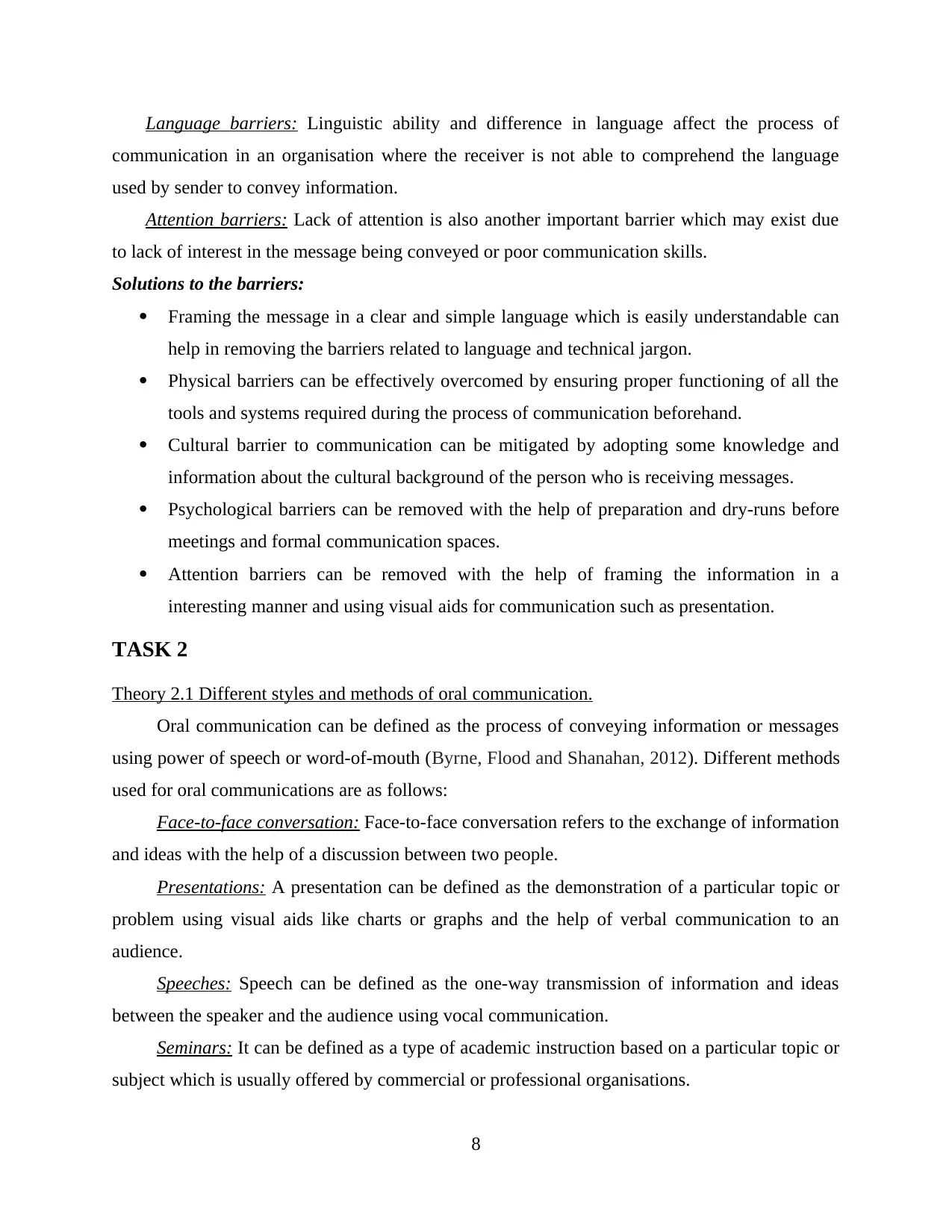
Language barriers: Linguistic ability and difference in language affect the process of
communication in an organisation where the receiver is not able to comprehend the language
used by sender to convey information.
Attention barriers: Lack of attention is also another important barrier which may exist due
to lack of interest in the message being conveyed or poor communication skills.
Solutions to the barriers:
Framing the message in a clear and simple language which is easily understandable can
help in removing the barriers related to language and technical jargon.
Physical barriers can be effectively overcomed by ensuring proper functioning of all the
tools and systems required during the process of communication beforehand.
Cultural barrier to communication can be mitigated by adopting some knowledge and
information about the cultural background of the person who is receiving messages.
Psychological barriers can be removed with the help of preparation and dry-runs before
meetings and formal communication spaces.
Attention barriers can be removed with the help of framing the information in a
interesting manner and using visual aids for communication such as presentation.
TASK 2
Theory 2.1 Different styles and methods of oral communication.
Oral communication can be defined as the process of conveying information or messages
using power of speech or word-of-mouth (Byrne, Flood and Shanahan, 2012). Different methods
used for oral communications are as follows:
Face-to-face conversation: Face-to-face conversation refers to the exchange of information
and ideas with the help of a discussion between two people.
Presentations: A presentation can be defined as the demonstration of a particular topic or
problem using visual aids like charts or graphs and the help of verbal communication to an
audience.
Speeches: Speech can be defined as the one-way transmission of information and ideas
between the speaker and the audience using vocal communication.
Seminars: It can be defined as a type of academic instruction based on a particular topic or
subject which is usually offered by commercial or professional organisations.
8
communication in an organisation where the receiver is not able to comprehend the language
used by sender to convey information.
Attention barriers: Lack of attention is also another important barrier which may exist due
to lack of interest in the message being conveyed or poor communication skills.
Solutions to the barriers:
Framing the message in a clear and simple language which is easily understandable can
help in removing the barriers related to language and technical jargon.
Physical barriers can be effectively overcomed by ensuring proper functioning of all the
tools and systems required during the process of communication beforehand.
Cultural barrier to communication can be mitigated by adopting some knowledge and
information about the cultural background of the person who is receiving messages.
Psychological barriers can be removed with the help of preparation and dry-runs before
meetings and formal communication spaces.
Attention barriers can be removed with the help of framing the information in a
interesting manner and using visual aids for communication such as presentation.
TASK 2
Theory 2.1 Different styles and methods of oral communication.
Oral communication can be defined as the process of conveying information or messages
using power of speech or word-of-mouth (Byrne, Flood and Shanahan, 2012). Different methods
used for oral communications are as follows:
Face-to-face conversation: Face-to-face conversation refers to the exchange of information
and ideas with the help of a discussion between two people.
Presentations: A presentation can be defined as the demonstration of a particular topic or
problem using visual aids like charts or graphs and the help of verbal communication to an
audience.
Speeches: Speech can be defined as the one-way transmission of information and ideas
between the speaker and the audience using vocal communication.
Seminars: It can be defined as a type of academic instruction based on a particular topic or
subject which is usually offered by commercial or professional organisations.
8
Paraphrase This Document
Need a fresh take? Get an instant paraphrase of this document with our AI Paraphraser
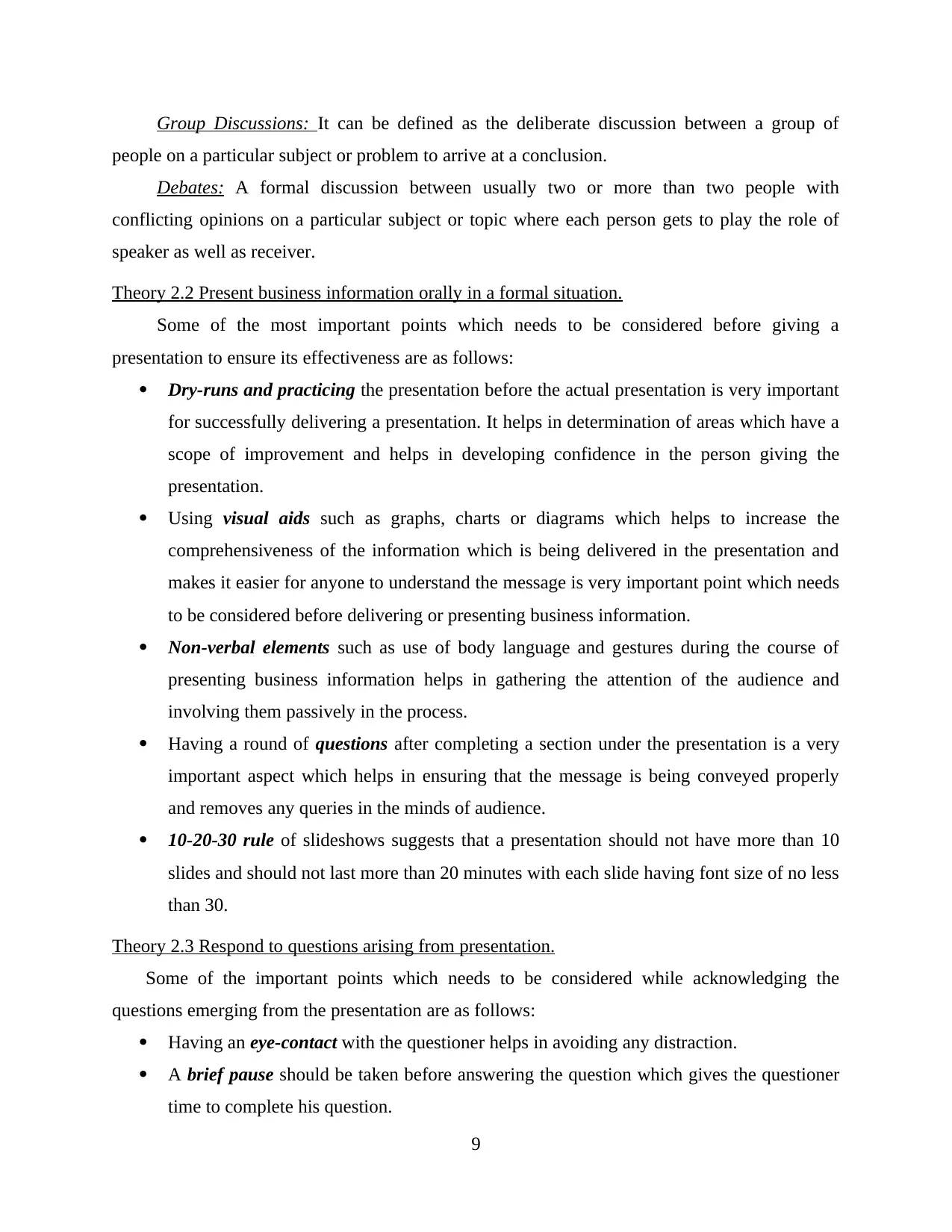
Group Discussions: It can be defined as the deliberate discussion between a group of
people on a particular subject or problem to arrive at a conclusion.
Debates: A formal discussion between usually two or more than two people with
conflicting opinions on a particular subject or topic where each person gets to play the role of
speaker as well as receiver.
Theory 2.2 Present business information orally in a formal situation.
Some of the most important points which needs to be considered before giving a
presentation to ensure its effectiveness are as follows:
Dry-runs and practicing the presentation before the actual presentation is very important
for successfully delivering a presentation. It helps in determination of areas which have a
scope of improvement and helps in developing confidence in the person giving the
presentation.
Using visual aids such as graphs, charts or diagrams which helps to increase the
comprehensiveness of the information which is being delivered in the presentation and
makes it easier for anyone to understand the message is very important point which needs
to be considered before delivering or presenting business information.
Non-verbal elements such as use of body language and gestures during the course of
presenting business information helps in gathering the attention of the audience and
involving them passively in the process.
Having a round of questions after completing a section under the presentation is a very
important aspect which helps in ensuring that the message is being conveyed properly
and removes any queries in the minds of audience.
10-20-30 rule of slideshows suggests that a presentation should not have more than 10
slides and should not last more than 20 minutes with each slide having font size of no less
than 30.
Theory 2.3 Respond to questions arising from presentation.
Some of the important points which needs to be considered while acknowledging the
questions emerging from the presentation are as follows:
Having an eye-contact with the questioner helps in avoiding any distraction.
A brief pause should be taken before answering the question which gives the questioner
time to complete his question.
9
people on a particular subject or problem to arrive at a conclusion.
Debates: A formal discussion between usually two or more than two people with
conflicting opinions on a particular subject or topic where each person gets to play the role of
speaker as well as receiver.
Theory 2.2 Present business information orally in a formal situation.
Some of the most important points which needs to be considered before giving a
presentation to ensure its effectiveness are as follows:
Dry-runs and practicing the presentation before the actual presentation is very important
for successfully delivering a presentation. It helps in determination of areas which have a
scope of improvement and helps in developing confidence in the person giving the
presentation.
Using visual aids such as graphs, charts or diagrams which helps to increase the
comprehensiveness of the information which is being delivered in the presentation and
makes it easier for anyone to understand the message is very important point which needs
to be considered before delivering or presenting business information.
Non-verbal elements such as use of body language and gestures during the course of
presenting business information helps in gathering the attention of the audience and
involving them passively in the process.
Having a round of questions after completing a section under the presentation is a very
important aspect which helps in ensuring that the message is being conveyed properly
and removes any queries in the minds of audience.
10-20-30 rule of slideshows suggests that a presentation should not have more than 10
slides and should not last more than 20 minutes with each slide having font size of no less
than 30.
Theory 2.3 Respond to questions arising from presentation.
Some of the important points which needs to be considered while acknowledging the
questions emerging from the presentation are as follows:
Having an eye-contact with the questioner helps in avoiding any distraction.
A brief pause should be taken before answering the question which gives the questioner
time to complete his question.
9
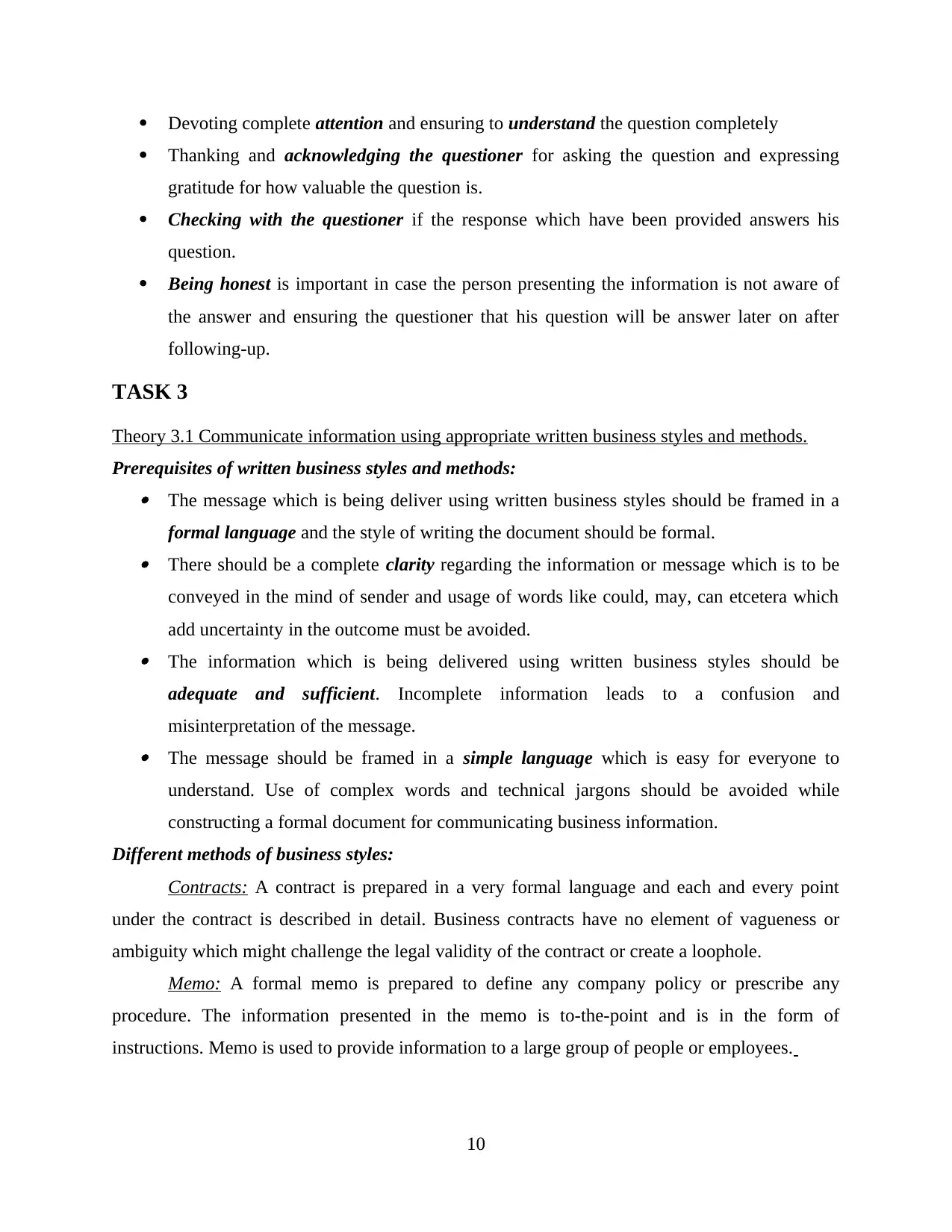
Devoting complete attention and ensuring to understand the question completely
Thanking and acknowledging the questioner for asking the question and expressing
gratitude for how valuable the question is.
Checking with the questioner if the response which have been provided answers his
question.
Being honest is important in case the person presenting the information is not aware of
the answer and ensuring the questioner that his question will be answer later on after
following-up.
TASK 3
Theory 3.1 Communicate information using appropriate written business styles and methods.
Prerequisites of written business styles and methods: The message which is being deliver using written business styles should be framed in a
formal language and the style of writing the document should be formal. There should be a complete clarity regarding the information or message which is to be
conveyed in the mind of sender and usage of words like could, may, can etcetera which
add uncertainty in the outcome must be avoided. The information which is being delivered using written business styles should be
adequate and sufficient. Incomplete information leads to a confusion and
misinterpretation of the message. The message should be framed in a simple language which is easy for everyone to
understand. Use of complex words and technical jargons should be avoided while
constructing a formal document for communicating business information.
Different methods of business styles:
Contracts: A contract is prepared in a very formal language and each and every point
under the contract is described in detail. Business contracts have no element of vagueness or
ambiguity which might challenge the legal validity of the contract or create a loophole.
Memo: A formal memo is prepared to define any company policy or prescribe any
procedure. The information presented in the memo is to-the-point and is in the form of
instructions. Memo is used to provide information to a large group of people or employees.
10
Thanking and acknowledging the questioner for asking the question and expressing
gratitude for how valuable the question is.
Checking with the questioner if the response which have been provided answers his
question.
Being honest is important in case the person presenting the information is not aware of
the answer and ensuring the questioner that his question will be answer later on after
following-up.
TASK 3
Theory 3.1 Communicate information using appropriate written business styles and methods.
Prerequisites of written business styles and methods: The message which is being deliver using written business styles should be framed in a
formal language and the style of writing the document should be formal. There should be a complete clarity regarding the information or message which is to be
conveyed in the mind of sender and usage of words like could, may, can etcetera which
add uncertainty in the outcome must be avoided. The information which is being delivered using written business styles should be
adequate and sufficient. Incomplete information leads to a confusion and
misinterpretation of the message. The message should be framed in a simple language which is easy for everyone to
understand. Use of complex words and technical jargons should be avoided while
constructing a formal document for communicating business information.
Different methods of business styles:
Contracts: A contract is prepared in a very formal language and each and every point
under the contract is described in detail. Business contracts have no element of vagueness or
ambiguity which might challenge the legal validity of the contract or create a loophole.
Memo: A formal memo is prepared to define any company policy or prescribe any
procedure. The information presented in the memo is to-the-point and is in the form of
instructions. Memo is used to provide information to a large group of people or employees.
10
⊘ This is a preview!⊘
Do you want full access?
Subscribe today to unlock all pages.

Trusted by 1+ million students worldwide
1 out of 14
Related Documents
Your All-in-One AI-Powered Toolkit for Academic Success.
+13062052269
info@desklib.com
Available 24*7 on WhatsApp / Email
![[object Object]](/_next/static/media/star-bottom.7253800d.svg)
Unlock your academic potential
Copyright © 2020–2025 A2Z Services. All Rights Reserved. Developed and managed by ZUCOL.




